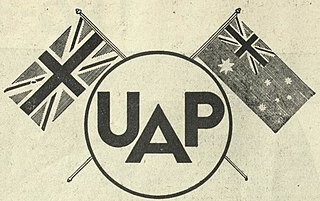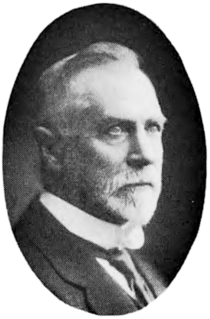Related Research Articles

The United Australia Party (UAP) was an Australian political party that was founded in 1931 and dissolved in 1945. The party won four federal elections in that time, usually governing in coalition with the Country Party. It provided two Prime Ministers of Australia – Joseph Lyons (1932–1939) and Robert Menzies (1939–1941).

The Nationalist Party, also known as the National Party was an Australian political party. It was formed on 17 February 1917 from a merger between the Commonwealth Liberal Party and the National Labor Party, the latter formed by Prime Minister Billy Hughes and his supporters after the 1916 Labor Party split over World War I conscription. The Nationalist Party was in government until electoral defeat in 1929. From that time it was the main opposition to the Labor Party until it merged with pro-Joseph Lyons Labor defectors to form the United Australia Party (UAP) in 1931. The party is a direct ancestor of the Liberal Party of Australia, the main centre-right party in Australia.

The Liberal–National Coalition, commonly known simply as "the Coalition", is an alliance of centre-right political parties that forms one of the two major groupings in Australian federal politics. The two partners in the Coalition are the Liberal Party of Australia and the National Party of Australia. Its main opponent is the Australian Labor Party (ALP); the two forces are often regarded as operating in a two-party system. The Coalition has been in government since the 2013 federal election, most recently being re-elected in the 2019 Australian federal election. The group is led by Scott Morrison as Prime Minister of Australia since August 2018.

The 1931 Australian federal election was held in Australia on 19 December 1931. All 75 seats in the House of Representatives and 18 of the 36 seats in the Senate were up for election.
The Victorian Farmers' Union (VFU) was an association of farmers and primary producers formed in 1914 in the Australian state of Victoria. Although initially formed as an "absolutely non-political" entity, the VFU became a political party in 1916, and nominated candidates for the 1917 state election and subsequent elections. In later years it used the names Victorian Country Party, then United Country Party and is now the National Party of Australia – Victoria. At the 1917 election, because the support for the VFU was concentrated in rural seats, it won four of the 11 seats in the Victorian Legislative Assembly it contested, gaining about 6% of the vote state-wide. In 1918 it also won its first seat in the federal parliament, after preferential voting was introduced. At the 1920 state election the VFU vote increased to 8% and the number of seats to 13, giving the VFU the balance of power in the state Legislative Assembly.
In parliamentary politics, balance of power is a situation in which one or more members of a parliamentary or similar chamber can by their uncommitted vote enable a party to attain and remain in minority government. The term may also be applied to the members who hold that position. The members holding the balance of power may guarantee their support for a government by either joining it in a coalition government or by an assurance that they will vote against any motion of no confidence in the government or will abstain in such a vote. In return for such a commitment, such members may demand legislative or policy commitments from the party they are to support. A person or party may also hold a balance of power in a chamber without any commitment to government, in which case both the government and opposition groupings may on occasion need to negotiate for that person's or party's support.
The National Party of Australia (WA) Inc, branded The Nationals WA, is a political party in Western Australia. It is affiliated with the National Party of Australia but maintains a separate structure and identity. Since the 2021 state election, the Nationals WA was the senior party in an opposition alliance with WA Liberal Party in the WA Parliament. Prior to the election, the National Party was sitting in the crossbench and the Liberal Party was the sole opposition party. The election resulted in the National Party winning more seats than the Liberal Party and gaining official opposition status. Under the opposition alliance, the National Party leader and deputy leader would be the opposition leader and deputy opposition leader respectively, the first since 1947, and each party would maintain their independence from each other.
This is a list of members of the Western Australian Legislative Assembly between the 1914 election and the 1917 election, together known as the Ninth Parliament. The re-election of Premier John Scaddan's Labor Government with a 26-24 majority in 1914 was tempered when, a year later, Labor member Joseph Gardiner's seat was declared vacant on account of his non-attendance and a Liberal was elected in his stead, and Labor became a minority government when on 18 December 1915, Edward Johnston resigned from the Labor Party and became an independent. On 27 July 1916, the Scaddan Ministry was defeated and the Liberals' Frank Wilson became the new Premier.
This is a list of members of the Western Australian Legislative Council from 22 May 1922 to 21 May 1924. The chamber had 30 seats made up of ten provinces each electing three members, on a system of rotation whereby one-third of the members would retire at each biennial election. During the term, the Country Party split into rival Ministerial (MCP) and Executive (ECP) factions–although in the Council, this was diluted somewhat by the refusal of some long-standing Country members to become involved in the dispute. The Executive faction, loyal to the Primary Producers' Association, prevailed and by 1925 the Ministerial faction had merged with the Nationalist Party.

Elections were held in the state of Western Australia on 8 April 1933 to elect all 50 members to the Legislative Assembly. The one-term Nationalist-Country coalition government, led by Premier Sir James Mitchell, was defeated by the Labor Party, led by Opposition Leader Philip Collier.

The 1924 Victorian state election was held in the Australian state of Victoria on Thursday 26 June 1924 to elect the 65 members of the state's Legislative Assembly.
Sydney Stubbs CMG was an Australian politician who served twice in the Parliament of Western Australia: in the Legislative Council from 1908 to 1911, and then in the Legislative Assembly from 1911 to 1947. He was Speaker of the Legislative Assembly from 1930 to 1933, and had been Mayor of Claremont and then Mayor of Perth prior to entering parliament.

Elections were held in the state of Western Australia on 26 March 1927 to elect all 50 members to the Legislative Assembly. The incumbent Labor Party government, led by Premier Philip Collier, won a second term in government against the United-Country opposition, led by Opposition Leader James Mitchell.

Elections were held in the state of Western Australia on 22 March 1924 to elect all 50 members to the Legislative Assembly. The incumbent Nationalist-Majority Country government, led by Premier James Mitchell, was defeated by the Labor Party opposition, led by Opposition Leader Philip Collier.
Elections were held in the state of Western Australia on 12 March 1921 to elect all 50 members to the Legislative Assembly. The incumbent government, led by Premier James Mitchell of the Nationalist Party and supported by the Country Party and National Labor Party, won a second term in government against the Labor Party opposition, led by Opposition Leader Philip Collier.
The Australian Labor Party , commonly known as Victorian Labor, is the semi-autonomous Victorian branch of the Australian Labor Party (ALP). The Victorian branch comprises two major wings: the parliamentary wing and the organisational wing. The parliamentary wing comprising all elected party members in the Legislative Assembly and Legislative Council, which when they meet collectively constitute the party caucus. The parliamentary leader is elected from and by the caucus, and party factions have a strong influence in the election of the leader. The leader's position is dependent on the continuing support of the caucus and the leader may be deposed by failing to win a vote of confidence of parliamentary members. By convention, the premier sits in the Legislative Assembly, and is the leader of the party controlling a majority in that house. The party leader also typically is a member of the Assembly, though this is not a strict party constitutional requirement.

Thomas Hamlet Harrison was an Australian politician who was a Country Party member of the Legislative Assembly of Western Australia from 1914 to 1924. He was the leader of the Country Party from 1919 to 1922.
John Lindsay was an Australian politician who served as a Country Party member of the Legislative Assembly of Western Australia from 1924 to 1933. He was a minister in the government of Sir James Mitchell.

The Liberal Party of Australia , branded as Liberal Western Australia, is the division of the Liberal Party of Australia in Western Australia. Founded in March 1949 as the Liberal and Country League of Western Australia (LCL), it simplified its name to the Liberal Party in 1968.
References
- ↑ "Western Australian 1924 Election". Australian Politics and Elections Database. University of Western Australia. Retrieved 17 July 2015.
- ↑ "Western Australian 1927 Election". Australian Politics and Elections Database. University of Western Australia. Retrieved 17 July 2015.